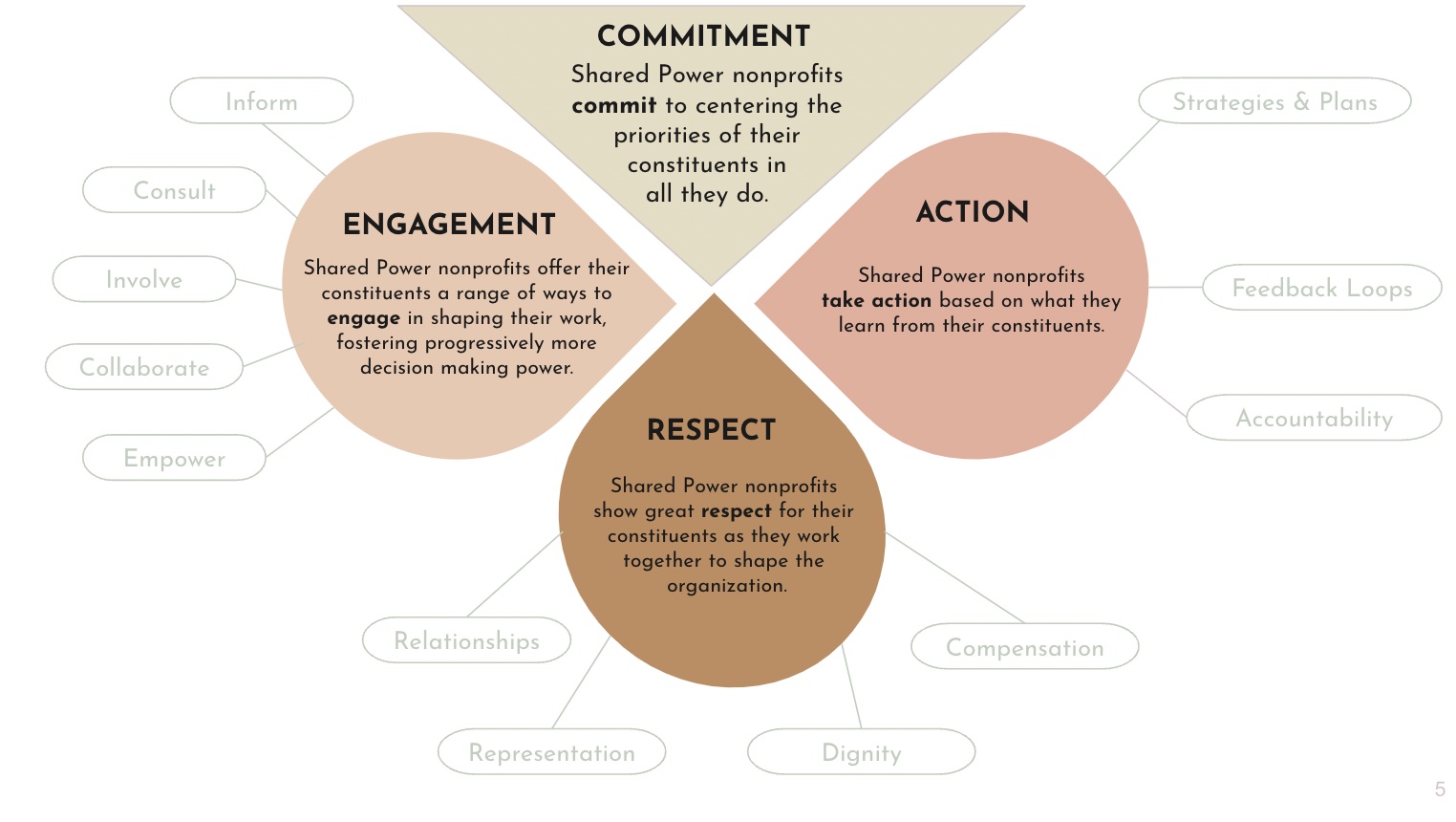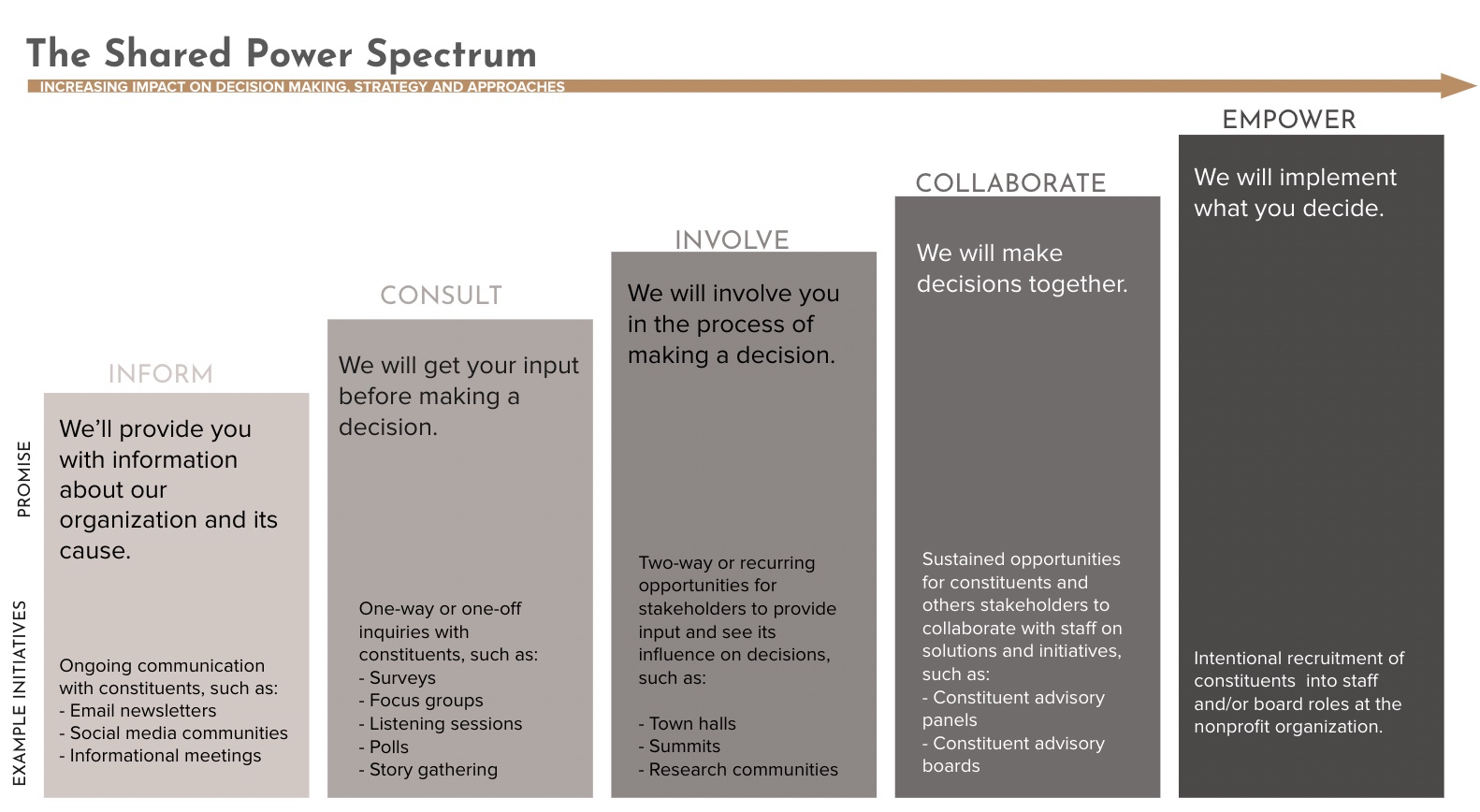When nonprofits share power with their constituents, they become more equitable and more effective, and better nonprofits build a better world. But what does it actually take to become a Shared Power Nonprofit?
We’ve explored this question with dozens of organizations in a range of mission areas over the last several years, and we’ve identified four key things that shared power organizations do differently:
- They commit to centering the priorities of their constituents in all they do
- They offer their constituents a range of ways to engage in shaping their work
- They show their constituents great respect as they work together to shape the organization
- They take action based on what they learn from their constituents
These ideas are more than just suggestions. They’re the Four Fundamentals of Shared Power Nonprofits. If you want to build a better organization, based on what your constituents truly want and need, these Four Fundamentals are imperatives.
Let’s break each of them down.

Shared Power Nonprofits commit to centering the priorities of their constituents in all they do
It is not enough to consult the people who utilize your nonprofit’s programs and services once every few years when your organization goes through strategic planning. Shared Power Nonprofits make a conscious commitment to center the priorities and preferences of their constituents in every important decision and action – from hiring a new leader, to designing a new program, to choosing grants to apply for, to developing marketing campaigns and fundraising appeals. This commitment typically begins at the board and leadership level and extends to every person on a nonprofit’s team, including both paid staff and volunteers.
So what does a commitment to centering constituents look like in practice?
Feeding America has committed to keeping people at the center as they work to address food insecurity. Each year, the organization brings people experiencing food insecurity together at an in-person summit to discuss what they see as the most important solutions to ending hunger. Those priorities then shape important decisions and actions across every aspect of the organization, from innovation, to advocacy, to food sourcing. Team members at every level and in every department know to consider how they can keep the priorities and preferences of people experiencing food insecurity (who they call “neighbors”) top of mind in every project they pursue. Often, this means asking neighbors for their input and perspectives on work in progress. For example, Feeding America recently adopted a strength-based communication approach as part of an evolution of the organization’s brand guidelines. As part of this work, the organization conducted a series of listening sessions with people experiencing food insecurity to understand how they wanted to be referred to and identified, and the organization then shaped its new strength-based brand guidelines according to their input.
Making a commitment to center constituents isn’t just for large federated organizations, either. For example, California Rural Legal Assistance, Inc. (CRLA) has made their commitment to centering their constituents, and has a department within the organization dedicated to language justice. This department facilitates participation within the organization by promoting and supporting people to speak in their native languages, leveraging translation and real-time interpretation. The nonprofit recently hosted its first statewide language justice and disability retreat, bringing together 40 advocates from 22 organizations to build community, explore current efforts to promote disability and language rights, and to craft the values and priorities that will guide collective efforts going forward.
Shared Power Nonprofits offer their constituents a range of ways to engage in shaping their work
Shared Power Nonprofits are serious about creating meaningful opportunities for their constituents to influence their work, and they know this requires offering a range of ways to get involved. They also know that some situations warrant handing full decision making power over to their constituents, while in other cases it is more appropriate to inform them or collaborate with them.
- Being transparent about what the organization is doing, what’s working and what’s not when it comes to making changes based on constituent input.
To help plan a holistic range of engagement opportunities, organizations can use our Shared Power Spectrum, which includes five modes of engagement that all Shared Power Nonprofits should aim to offer their constituents: inform, consult, involve, collaborate and empower.

As you can see, the Spectrum suggests structuring constituent engagement opportunities based on a progressive continuum of increasing influence on decisions. As they progress, Shared Power Nonprofits move from only offering one-way engagement with their stakeholders (where stakeholders provide input and a nonprofit responds), to two-way, deliberative engagement (where a nonprofit works hand-in-hand with its stakeholders in a sustained manner to shape solutions).
Here are some engagement opportunities that a nonprofit might consider offering in each mode of the Spectrum:
- Inform: Ongoing communication with constituents such as email newsletters, social media communities and informational meetings
- Consult: Surveys, focus groups, listening sessions, polls, story gathering
- Involve: Town halls, summits, research communities
- Collaborate: Stakeholder advisory panels, stakeholder/community boards
- Empower: Intentional recruitment of constituents into staff and governing board roles
The strongest Shared Power Nonprofits offer engagement opportunities across all five modes of engagement, and choose the appropriate methods for each situation and each stakeholder.
Shared Power Nonprofits show their constituents great respect as they work together to shape the organization
Shared Power Nonprofits know that they can only build better organizations for the good of the people and communities they serve when they eschew saviorism and treat their constituents as the equals they are. They prioritize respect in each and every interaction with their constituents, keeping the following principles in mind:
- Relationships: Shared Power Nonprofits build real, human relationships with their constituents first, before asking for their input and ideas. They see constituent engagement as interaction in the scope of a larger relationship, not a one-and-done transaction.
- Representation: When Shared Power Nonprofits engage their constituents in shaping their work, they aim to do so in a way that is representative of the entire population they aim to serve. For example, if a nonprofit serves 60% women and 70% African American individuals, they’d aim to include those same identities proportionally in a survey or focus group.
- Dignity: Shared Power Nonprofits recognize that it is not always easy for their constituents to provide input about their experiences in order to shape the organization’s work. Conversations and engagement opportunities can lead to feelings of shame and discomfort, and in some cases, even retraumatization. Shared Power Nonprofits always begin by asking constituents what they need to have a dignified experience engaging with the organization, and design engagement opportunities accordingly. A few common practices include offering opportunities for anonymity, hiring identity-aligned facilitators for listening sessions, and ensuring everyone involved in constituent engagement has trauma-informed training.
- Compensation: Shared Power Nonprofits recognize that their constituents deserve to be compensated for the time they spend providing input that shapes the organization. While not every engagement opportunity necessarily needs to be compensated, Shared Power Nonprofits have a defined, transparent and fair compensation policy. They pay their constituents at least fair market rates comparable to what someone may make from engaging with a business in a similar way.
Shared Power Nonprofits take action based on what they learn from their constituents
The intent to share power means nothing if it doesn’t result in meaningful action. Shared Power Nonprofits don’t just listen to what their constituents say they want and need. They listen and then they change as a result of what they hear. This means:
- Shaping strategies and plans based on constituent input. A Shared Power Nonprofit’s strategic plan, marketing and fundraising plans, program plans etc. should all be based on direction from constituents, and therefore so should the organization’s priorities and key activities.
- Creating feedback loops so constituents always know how their input was utilized.
- Holding the organization accountable to the scrutiny of constituents, not just funders and donors.
While these Four Fundamentals are essential, no Shared Power nonprofit does them all perfectly, especially not at first. Sharing Power is a long journey, not a final destination. The Fundamentals provide valuable guideposts along the way, and an ideal state to strive for.
Are you interested in transforming your organization into a Shared Power Nonprofit?
Earlier this year, many of you told us “YES!” when we asked this question in a survey. Since then, we’ve been hard at work creating a first-of-its-kind opportunity for nonprofit leaders like you to learn how to put Shared Power principles into practice, working alongside other like minded nonprofit executives across the country. Want to be the first to know when it launches next month? Make sure to add your name to the list here.